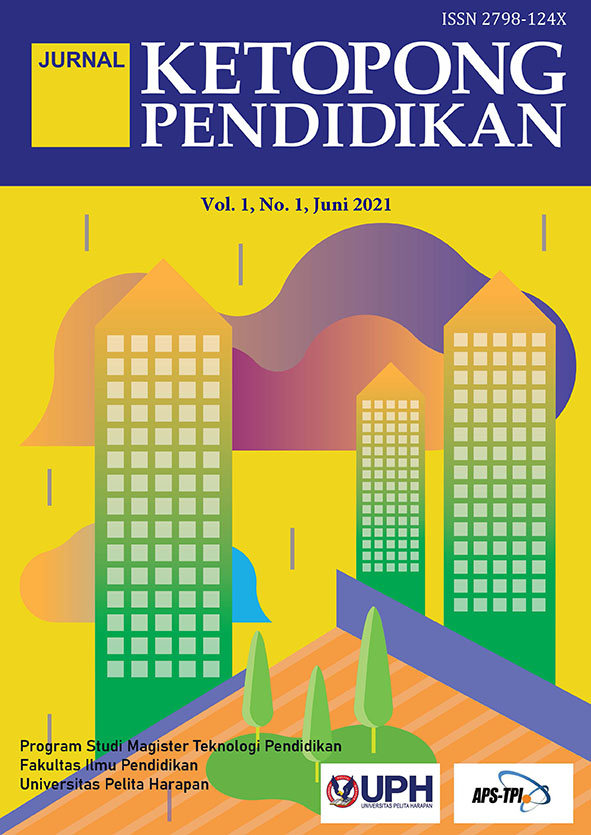PENTINGNYA KUALITAS KEHIDUPAN KERJA, STRES KERJA, DAN KEPUASAN KERJA DALAM MENINGKATKAN KOMITMEN ORGANISASI GURU [THE IMPORTANCE OF QUALITY OF WORK LIFE, JOB STRESS, AND JOB SATISFACTION IN INCREASING THE ORGANIZATIONAL COMMITMENT OF TEACHERS]
DOI:
https://doi.org/10.19166/jkp.v1i1.3557Nyckelord:
work life, job stress, job satisfaction, organizational commitmentAbstract
Teachers are key in the formal education system. The school as an organization ideally has high committed members, thus avoiding turnover, since the effect of turnover is harmful to the school existence and the students also. This research aims to determine the effect of quality of work life, job stress, and job satisfaction on organizational commitment of the teachers in XYZ Elementary School. The research using closed questionnaire with Likert scale and the research subjects were 42 teachers. The design used in this study was SEM-PLS with outer model and inner model. The result showed that quality of work life has positive influence to organizational commitment, job stress influenced positively to organizational commitment, and job satisfaction has positive influence to organizational commitment. The research also found that quality of work life has positive influence to job satisfaction, while job stress influenced positively to job satisfaction.
Referenser
Birjandi, M., Birjandi, H., & Ataei, M. (2013). The relationship between the quality of work life and organizational commitment of the employees of Darab cement company: Case study in Iran. International Journal of Economics, Bussiness and Finance, 1(7), 154-164. http://www.ijebf.com/Vol.%201,%20No.%207,%20August%202013.php
Çetinkanat, A. C., & Kösterelioğlu, M. A. (2016). Relationship between quality of work life and work alienation: Research on teachers. Universal Journal of Educational Research, 4(8), 1778-1786. https://doi.org/10.13189/ujer.2016.040806
Colquitt, J. A., Lepine, J. A., & Wesson, M. J. (2015). Organizational behavior: Improving performance and commitment in the workplace. McGraw Hill-Education.
Garcia, C. M., Slate, J. R., & Delgado, C. T. (2009). Salary and ranking and teacher turnover: A statewide study. International Journal of Education Policy & Leadership, 4(7), 1-11. https://doi.org/10.22230/ijepl.2009v4n7a114
Farid, H., Izadi, Z., Ismail, I. A., & Alipour, F. (2015). Relationship between quality of work life and organizational commitment among lecturers in a Malaysian public research university. The Social Science Journal, 52(1), 54-61. https://doi.org/10.1016/j.soscij.2014.09.003
Gibson, J. L., Ivancevich, J. M., Donnelly, J. H., & Konopaske, R. (2012). Organization: Behavior, structure, processes (14th ed.). McGraw-Hill Irwin.
Hartono, B., & Setiawan, R. (2013). Pengaruh komitmen organisasional terhadap kepuasan kerja karyawan Paparon’s Pizza City of Tomorrow. AGORA, 1(1), 1-8. https://media.neliti.com/media/publications/36244-ID-pengaruh-komitmen-organisasional-terhadap-kepuasan-kerja-karyawan-paparons-pizza.pdf
Khalatbari, J., Ghorbanshiroudi, S., & Firouzbakhsh, M. (2013). Correlation of job Stress, job satisfaction, job motivation and burnout and feeling stress. Procedia - Social and Behavioral Sciences, 84, 860-863. https://doi.org/10.1016/j.sbspro.2013.06.662
Kloss, T. E. (2013). High school band students’ perspectives of teacher turnover. Research & Issues in Music Education, 11(1). https://files.eric.ed.gov/fulltext/EJ1015699.pdf
Nakra, R. (2014). Understanding the impact of organizational justice on organizational commitment and projected job stay among employees of the business process outsourcing sector in India. Vision: The Journal of Business Perspective, 18(3), 185-194. https://doi.org/10.1177/0972262914539217
Narehan, H., Hairunnisa, M., Norfadzillah, R. A., & Freziamella, L. (2014). The effect of quality of work life (QWL) programs on quality of life (QOL) among employees at multinational companies in Malaysia. Procedia - Social and Behavioral Sciences, 112, 24-34. https://doi.org/10.1016/j.sbspro.2014.01.1136
Nayak, T., & Sahoo, C. K. (2015). Quality of work life and organizational performance: The mediating role of employee commitment. Journal of Health Management, 17(3), 263-273. https://doi.org/10.1177/0972063415589236
Okçu, V., & Çetin, H. (2017). Investigating the relationship among the level of mobbing experience, job satisfaction and burnout levels of primary and secondary school teachers. Universal Journal of Education Research, 5(1), 148-161. https://doi.org/10.13189/ujer.2017.050119
Pratiwi, K., & Himam, F. (2014). Kualitas kehidupan kerja ditinjau dari kepuasan kerja dan persepsi terhadap kinerja. Jurnal Psikologi, 13(1), 42-49. https://doi.org/10.14710/jpu.13.1.42-49
Robbins, S. P., & Judge, T. A. (2017). Organizational behavior (7th ed.). Pearson.
Ronfeldt, M., Loeb, S., & Wyckoff, J. (2011). How teacher turnover harms students achievement. American Educational Research Journal, 50(1), 4-36. https://journals.sagepub.com/doi/abs/10.3102/0002831212463813
Schermerhorn, J. R., Jr. (2012). Organizational behavior (12th ed.). John Wiley & Sons.
Sinding, K., Waldstrøm, C., Kreitner, R., & Kinicki, A. (2014). Organizational behavior. McGraw-Hill Education.
Xiang, H., Coleman, S., Johannsson, M., & Bates, R. (2014). Workplace stress and job satisfaction among biologics development professionals. Health, 6(14), 1790-1802. https://doi.org/10.4236/health.2014.614211
Wibowo. (2015). Perilaku dalam organisasi. RajaGrafindo Persada.
Wirawan. (2014). Kepemimpinan: Teori, psikologi, perilaku organisasi, aplikasi dan penelitian. RajaGrafindo Persada.
##submission.downloads##
Publicerad
Nummer
Sektion
Licens
Authors who publish with this journal agree to the following terms:
1) Authors retain copyright and grant the journal right of first publication with the work simultaneously licensed under a Creative Commons Attribution License (CC-BY-SA 4.0) that allows others to share the work with an acknowledgement of the work's authorship and initial publication in this journal.
2) Authors are able to enter into separate, additional contractual arrangements for the non-exclusive distribution of the journal's published version of the work (e.g., post it to an institutional repository or publish it in a book), with an acknowledgement of its initial publication in this journal.
3) Authors are permitted and encouraged to post their work online (e.g., in institutional repositories or on their website). The final published PDF should be used and bibliographic details that credit the publication in this journal should be included.


